COMBINING LIKE TERMS
Subscribe to our ▶️ YouTube channel 🔴 for the latest videos, updates, and tips.
To simplify (addition or subtraction) algebraic expressions, we need to combine like terms.
To combine like terms, we must be aware like terms and unlike terms.
Like Terms or Similar Terms :
Like terms are the terms which have the same variables with same exponent for each variable.
Example :
7x, 3x, - 4x
Unlike Terms or Dissimilar Terms :
Unlike terms are the terms which have same variables or different variables.
If they have same variables, the exponents will not be same.
Example :
9x2, 5xy, - 4xy2, y, 6
More clearly,
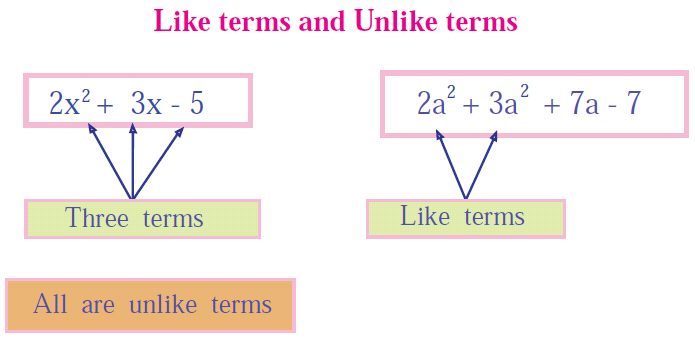
Note :
To do simplification (addition and subtraction) of algebraic expression, we can combine only like terms, not unlike terms.
Example 1 :
Add :
3x3 + x2 - 2 and 2x2 + 5x + 5
Solution :
First we have to arrange the like terms column wise and add them.

Observe the important points related to the above work.
1. We have written the term 2x2 of the second polynomial below the corresponding term x2 of the first polynomial.
(Because x2 and 2x2 are like terms and they can be combined)
2. Similarly, the constant term +5 is placed below the constant term – 2.
3. Since the term x in the first polynomial and the term x3 in the second polynomial do not exist, their respective places have been left blank to facilitate the process of addition. Or, for the non existing terms, we annex the terms with zero coefficients.
Example 2 :
Find out the sum of the polynomials :
3x - y, 2y - 2x, and x + y
Solution :
We can find out the sum of the given polynomials using either column method of addition or row method of addition as explained below.
Once they are written in the above methods, we have to combine the like terms.

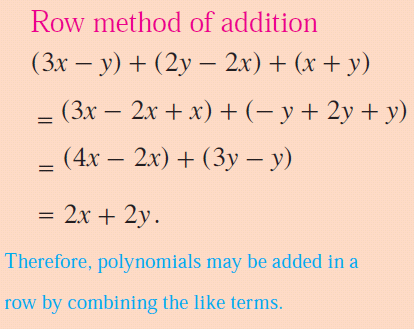
Example 3 :
Subtract 5xy from 8xy.
Solution :
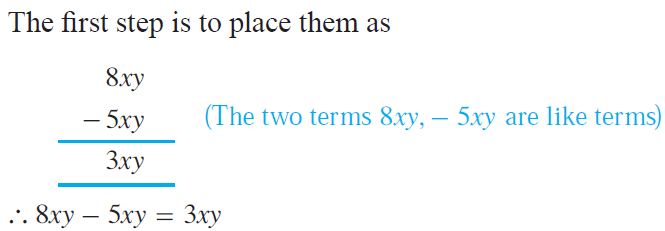
Example 4 :
Subtract (3c + 7d2) from (5c - d2).
Solution :

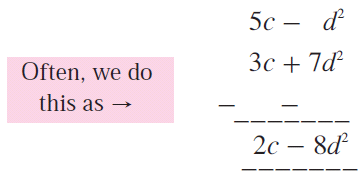
Alternatively, this can also be done as :
(5c - d2) - (3c + 7d2) :
= 5c - d2 - 3c - 7d2
= (5c - 3c) + (-d2 - 7d2)
= 2c + (-8d2)
= 2c - 8d2
Example 5 :
Subtract (2x2 + 2y2 - 6) from (3x2 - 7y2 + 9).
Solution :

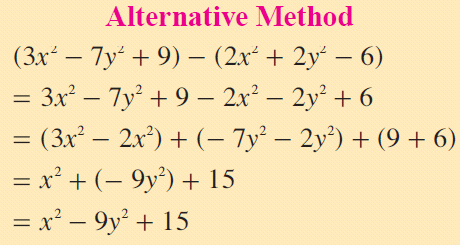
Example 6 :
Add :
(7p3 + 4p2 - 8p + 1) and (3p3- 5p2- 10p + 5)
Solution :
= (7p3 + 4p2- 8p + 1) + (3p3- 5p2- 10p + 5)
= 7p3 + 4p2- 8p + 1 + 3p3- 5p2- 10p + 5
Group like terms together.
= (7p3 + 3p3) + (4p2- 5p2) + (-8p - 10p) + (1 + 5)
Combine like terms.
= 10p3 - p2 -18p + 6
Example 7 :
Add :
2(x3 - x2 + 6x - 2) and (5x6 + 7x5 - 3x - 3)
Solution :
= 2(x3 - x2 + 6x - 2) + (5x6 + 7x5 - 3x - 3)
Distributive property.
= 2x3 - 2x2 + 12x - 4 + 5x6 + 7x5 - 3x - 3
Group like terms together.
= 5x6 + 7x5 + 2x3 - 2x2 + (12x - 3x) + (-4 - 3)
Combine like terms.
= 5x6 + 7x5 + 2x3 - 2x2 + 9x - 7
Example 8 :
Add :
-1(x6 + x3 + 6x2 - 2) and 2(5x6 + 7x5 - 3x - 3)
Solution :
= -1(x6 + x3 + 6x2 - 2) + 2(5x6 + 7x5 - 3x - 3)
Distributive property.
= -x6 - x3 - 6x2 + 2 + 10x6 + 14x5 - 6x - 6
Group like terms together.
= (-x6 + 10x6) + 14x5 - x3 - 6x2 - 6x + (2 - 6)
Combine like terms.
= 9x6 + 14x5 - x3 - 6x2 - 6x - 4
Example 9 :
Subtract (12x3 + 14x2 + 17x - 12) from (15x3 + 22x2 + 17x - 19).
Solution :
= (15x3 + 22x2 + 17x - 19) - (12x3 + 14x2 + 17x - 12)
Distributive Property.
= 15x3 + 22x2 + 17x - 19 - 12x3 - 14x2 - 17x + 12
Group like terms together.
= (15x3 - 12x3) + (22x2 - 14x2) + (17x - 17x) + (-19 + 12)
Combine like terms.
= 3x3 + 8x2 + 0x - 7
= 3x3 + 8x2 - 7
Example 10 :
Subtract (5x3 + 3x2 + 7x - 6) from (3x3 + 2x2 + 6x - 4).
Solution :
= (3x3 + 2x2 + 6x - 4) - (5x3 + 3x2 + 7x - 6)
Distributive Property.
= 3x3 + 2x2 + 6x - 4 - 5x3 - 3x2 - 7x + 6
Group like terms together.
= (3x3 - 5x3) + (2x2 - 3x2) + (6x - 7x) + (-4 + 6)
Combine like terms.
= -2x3 - x2 - x + 2
Example 11 :
Simplify :
(a + b)(a - b) - (a2 + b2)
Solution :
= (a + b)(a - b) - (a2 + b2)
= a2 - b2 - (a2 + b2)
= a2 - b2 - a2 - b2
= -2b2
Example 12 :
Simplify :
(a + b)3 - (a - b)3
Solution :
We can use the following algebraic identities to simplify the given expressions.
(a + b)3 = a3 + 3a2b + 3ab2 + b3
(a - b)3 = a3 - 3a2b + 3ab2 - b3
(a + b)3 - (a - b)3 :
= (a3 + 3a2b + 3ab2 + b3) - (a3 - 3a2b + 3ab2 - b3)
= a3 + 3a2b + 3ab2 + b3 - a3 + 3a2b - 3ab2 + b3
= 3a2b + b3 + 3a2b + b3
= 6a2b + 2b3
Practice Questions
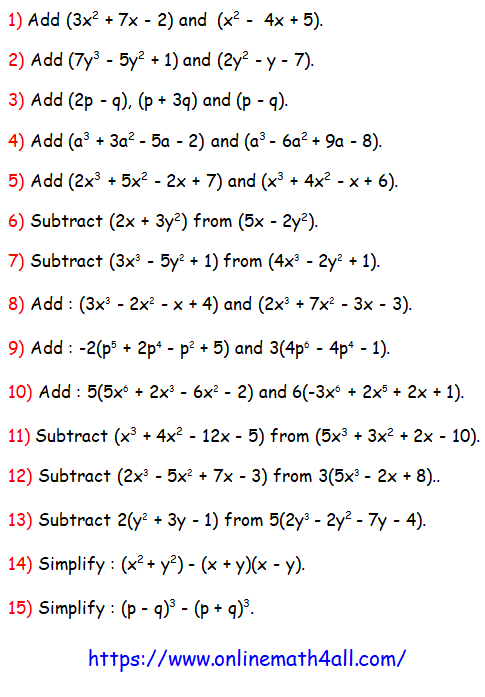
Click here to get detailed answers for the above questions.
Subscribe to our ▶️ YouTube channel 🔴 for the latest videos, updates, and tips.
Kindly mail your feedback to v4formath@gmail.com
We always appreciate your feedback.
About Us | Contact Us | Privacy Policy
©All rights reserved. onlinemath4all.com

Recent Articles
-
US Common Core K-12 Curricum Algebra Solving Simple Equations
Jan 06, 26 04:54 AM
US Common Core K-12 Curricum Algebra Solving Simple Equations -
10 Hard SAT Math Questions (Part - 4)
Jan 05, 26 06:56 PM
10 Hard SAT Math Questions (Part - 4) -
10 Hard SAT Math Questions (Part - 3)
Jan 05, 26 06:34 PM
10 Hard SAT Math Questions (Part - 3)

